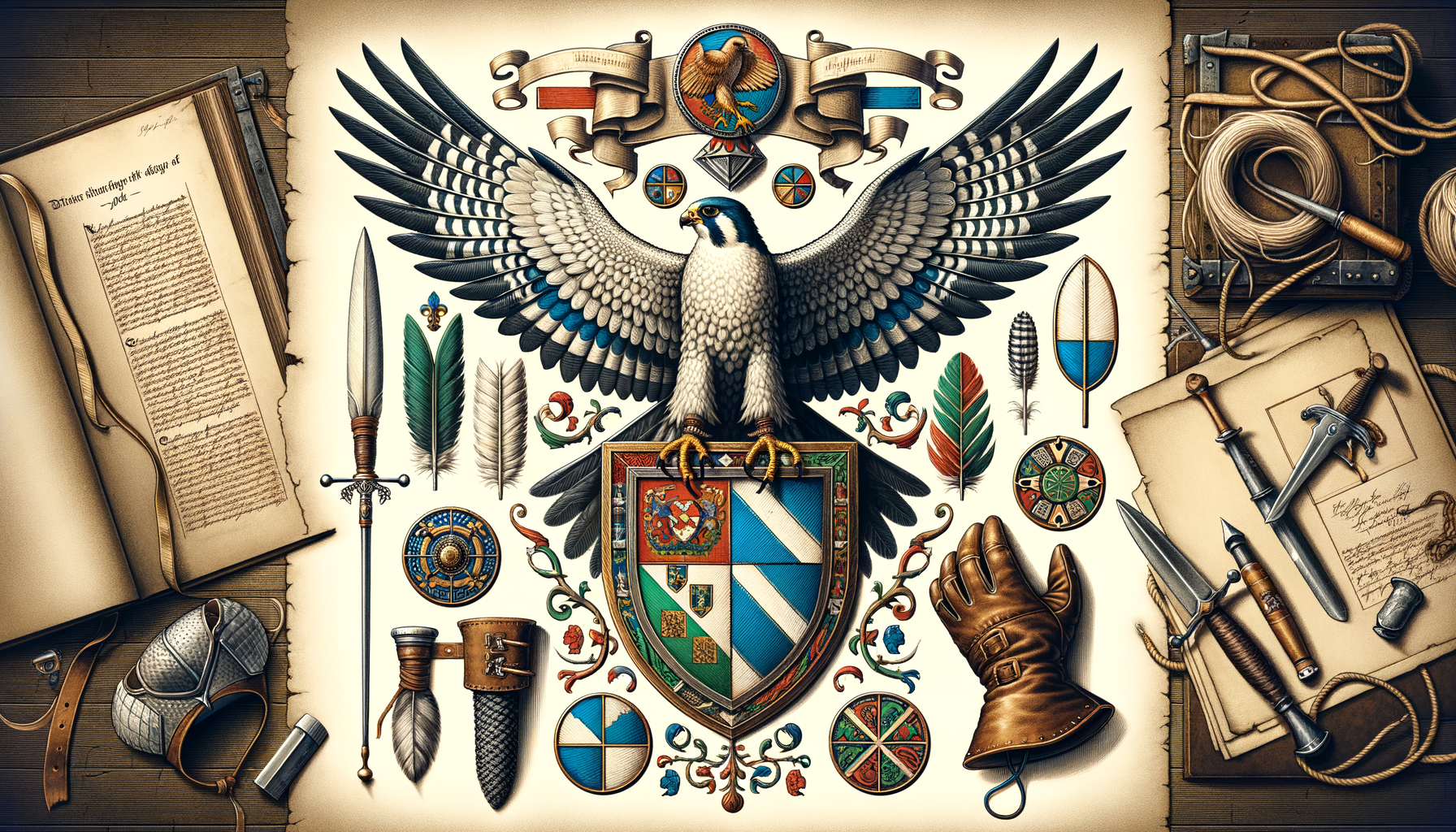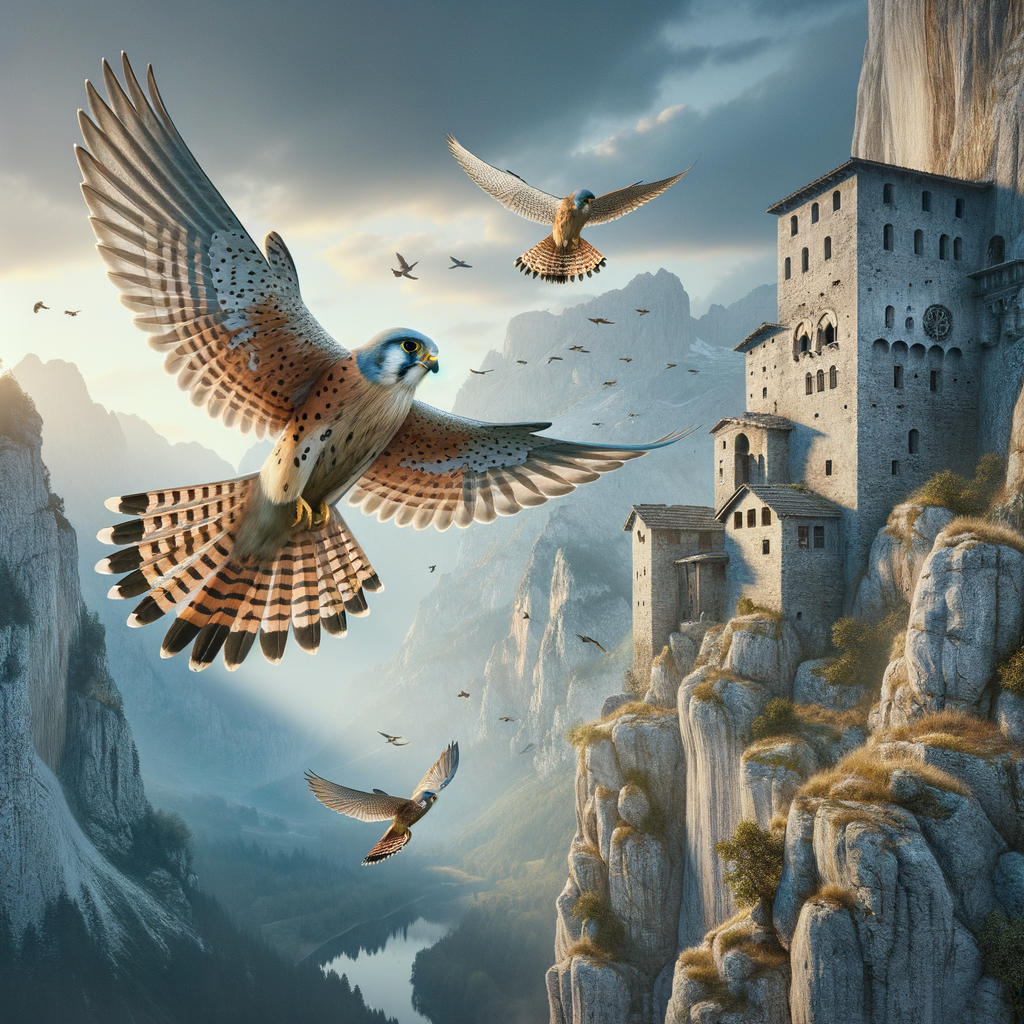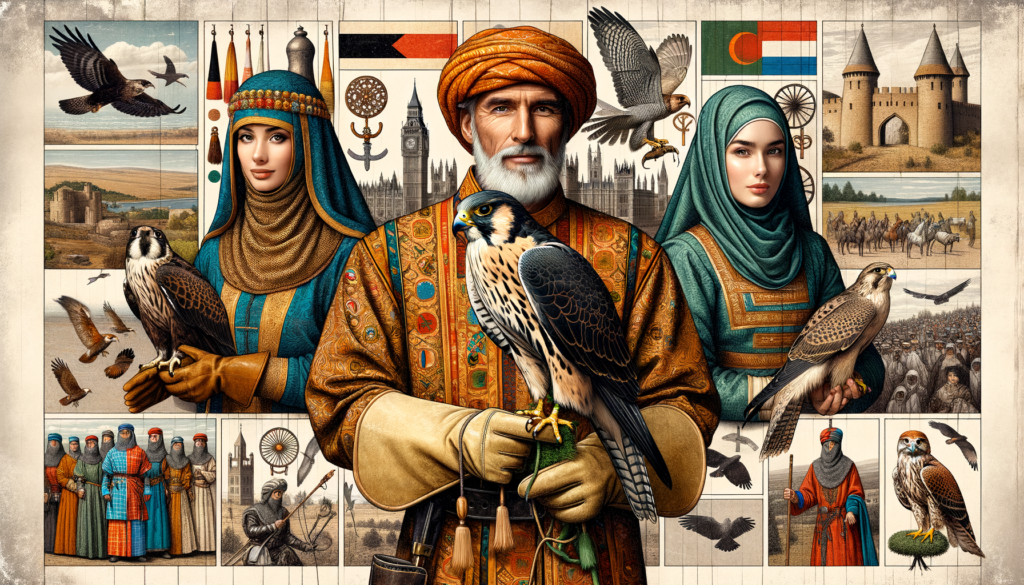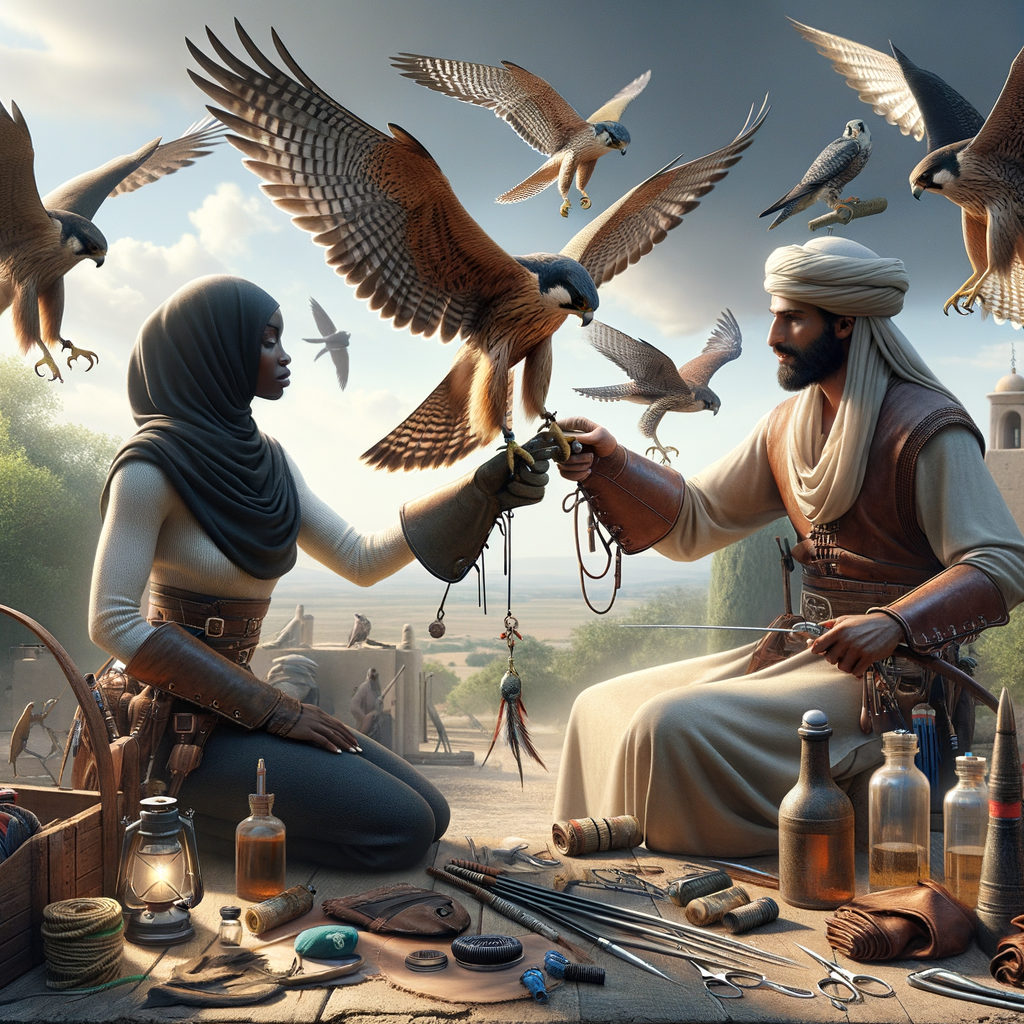Symbols and Significance of Falconry in Heraldry
- Falconry is an ancient practice symbolizing nobility and chivalry.
- Falcons and other birds of prey are common symbols in heraldry, representing swiftness, determination, and keen vision.
- These birds are often depicted with specific attributes, like a falcon with bells, indicating readiness and trained skill.
- The falcon in heraldry is also associated with the qualities of leadership and loyalty.
Different birds have different meanings; for example, an eagle often symbolizes courage and strength, while a hawk might represent strategic thinking.
- The presence of falconry symbols in a family crest reflects a noble lineage and an esteemed social status.
- Understanding these symbols helps in appreciating the rich historical context and the values upheld in heraldic traditions.
- In heraldry, the pose and condition of the bird, such as flying or perched, convey various messages and qualities.
Discovering the Mystical Symbols of Falconry and Heraldry
Welcome to the mesmerizing world of falconry and heraldry, where ancient traditions and majestic birds come together in a dance of symbolism and history! Just like the enchanting Irish folktales filled with mythical creatures and noble heroes, the symbols used in falconry and heraldry hold deep meanings and tales of their own. Here at Learn Falconry, we’re passionate about sharing these fascinating stories with you.
Imagine walking through the emerald hills of Ireland; every stone wall and ancient castle tells a story of bravery, honor, and legacy. The same goes for falconry and heraldry! These symbols aren’t just artistic designs ‘ they carry the wisdom and values of generations past. By learning about these symbols, you’re opening a treasure chest of knowledge that connects you to the noble art of falconry and the rich history of heraldic traditions.
In this article, you’ll uncover the hidden meanings behind some of the most captivating symbols in falconry. You’ll learn how these symbols have influenced the way we portray nobility, courage, and freedom, just as Irish legends have shaped the island’s cultural heritage. Let’s embark on this journey together, exploring the enchanting tales and timeless wisdom of falconry and heraldry that continue to inspire us today. Keep reading to discover the magical world that awaits!
The Fascinating World of Falconry Symbols and Heraldry
The Significance of Falconry Symbols
Falconry symbols have been an integral part of the falconry tradition for centuries. These symbols, often seen as artful representations, hold deep meanings and tell fascinating stories about the rich history of falconry. From coats of arms to family crests, these symbols are not just decorative but also showcase the valor and nobility associated with falconry.
Falconry symbols can be found in various forms, such as depictions of falcons in flight, hunting scenes, or falcons perched on gloves. Each of these symbols highlights a specific aspect of falconry, whether it’s the skill of the falconer, the speed and agility of the falcon, or the partnership between human and bird. To delve deeper into this ancient practice, explore our comprehensive history of falconry.
The Role of Falconry in Heraldry
Falconry in heraldry is an intriguing subject. Heraldic designs, which are essentially emblematic devices used to represent individuals, families, or institutions, often feature falconry elements to signify certain virtues. Historically, a falcon in heraldry symbolizes keen sight, determination, and the noble qualities of the bird itself. It is a testament to the bird’s esteemed status in various cultures and its association with nobility and hunting.
These emblems were not just limited to shields and banners but also appeared on personal items such as rings, seals, and armor. Falcons in heraldry represent attributes such as bravery, perseverance, and high status. For a more detailed look at how falconry has influenced different cultures, visit falconry in cultures.
Unveiling Historical Falconry Symbols
Historical falconry symbols can be traced back to ancient civilizations where falconry was a revered sport and a symbol of power. Ancient Egyptian murals and scripts, for example, depicted falconry as a royal pastime. In medieval Europe, the falcon became synonymous with lordship and sovereignty. Noble families often had falconry scenes embroidered on their tapestries and depicted in their manuscripts.
In different parts of the world, the use of these historical symbols varied but consistently underscored the powerful bond between humans and falcons. Whether through carvings, paintings, or metalwork, these symbols serve as historical documents that provide insights into the ancient practice of falconry. For an in-depth exploration of this topic, you can read more about falconry in Medieval Europe and ancient origins of falconry.
Why Falconry Symbols Matter
Understanding falconry symbols is not just about appreciating art or historical artifacts; it’s about recognizing the rich cultural heritage that these symbols represent. They provide a visual link to the past, connecting us to the traditions and values of previous generations. These symbols are educational tools that help us learn about historical practices, social structures, and the evolution of falconry over the centuries.
At Learn Falconry, we cherish and preserve these symbols as they are crucial to the legacy of falconry. To get started on your own journey with falconry, check out falconry for beginners and falconry techniques. By exploring these resources, you’ll develop a deeper appreciation not only for the sport itself but also for the rich tapestry of history that it embodies.
For more engaging content and detailed information, be sure to visit our falconry symbols and heraldry page.
Visit Learn Falconry’s website for more information on the fascinating world of falconry!
Falconry Symbols in Heraldry: The Legacy and Cultural Impact
Falconry is not just a sport; it’s an ancient art that has left an indelible mark on various cultures through history. Let’s explore the rich symbolism it holds in heraldry:
Falconry as Intangible Cultural Heritage
Falconry was added to the UNESCO Representative List of the Intangible Cultural Heritage of Humanity in 2010. This prestigious recognition shows how important falconry is across many cultures. It isn’t just a hobby; it’s a tradition passed down through mentoring, family, and training clubs. Falconry brings people together, fostering a sense of community and shared heritage.
Historical Context: Falconry in Britain and the United States
In medieval Britain, falconry was a pastime of the Norman nobility. They even had special equipment like the “cadge,” a frame used to transport falcons. This practice wasn’t just for fun; it was a status symbol and a key part of their cultural identity.
Across the pond in the United States, falconry is also a significant sport. It experienced a revival in the 1970s, spurred by renewed interest via old treatises and media coverage. Today, it’s particularly popular in regions like Central Asia and the Persian Gulf, besides America.
Specialized Falconry Equipment
Falconry has its own gear, each piece designed for a specific purpose. Here’s a table summarizing common falconry equipment:
| Equipment | Purpose |
|---|---|
| Leather Gloves | Protects the falconer’s hand from talons |
| Hoods | Covers the bird’s eyes to keep it calm |
| Jesses | Thin straps attached to the bird’s legs for control |
| Mews | Indoor housing for birds of prey |
Techniques of Falconry
Falconry involves a symbiotic relationship between the bird and its trainer. Common techniques include:
- Hoods: These cover the hawk’s eyes to keep it calm.
- Jesses: These straps help control the bird.
- Mews: Custom-built houses for birds.
Symbolism of Falcons
Falcons hold deep symbolic meanings. Here’s a breakdown:
| Symbolism | Description |
|---|---|
| Vision, Clarity, and Foresight | Falcons stand for intelligence, focus, and the ability to envision future goals. |
| Independence and Self-Reliance | They symbolize self-sufficiency and strong territorial instincts. |
| Power and Precision | Known for speed and agility, they represent nobility, precision, and authority. |
| Victory and Triumph | Their hunting prowess makes them symbols of skill, strategy, and triumph. |
| Ambition and Determination | Falcons epitomize relentless pursuit of success and unwavering dedication to goals. |
Falcons in Heraldic Postures
In heraldry, falcons are depicted in specific postures to distinguish them from other birds. The key postures are:
- Rising: Depicts the bird in a state of motion, often symbolizing ascension or readiness.
- Close: Shows the bird at rest or perched, reflecting a state of peace or readiness to take flight.
Falcons have been used in various heraldic designs to convey messages of power, vision, and triumph. Their representation varies, but the underlying messages remain constant.
Falconry’s rich legacy and the symbolic prowess of falcons continue to captivate and inspire people across the globe. Whether in medieval times or modern-day celebrations, falcons remain an enduring symbol of power, vision, and cultural heritage.
Timeless Symbols of Falconry in Heraldry
Falconry holds a unique place in our history and culture, spanning different times and regions. Here are some key points about its enduring symbolism:
- Cultural Heritage: Falconry is recognized globally for its cultural importance, even earning a spot on UNESCO’s list of Intangible Cultural Heritage of Humanity. It’s a tradition passed down through mentoring, families, and clubs, practiced worldwide.
- Historical Prestige: Whether in medieval Britain or the United States, falconry has been a beloved pastime of nobility and enthusiasts. Old treatises and new media have brought the sport back to life, highlighting its enduring appeal.
- Significant Symbols: Falcons symbolize vision, clarity, and foresight, thanks to their sharp hunting skills. They also represent independence, power, precision, victory, ambition, and determination’qualities that continue to inspire people today.
- Heraldic Representation: In heraldry, falcons are depicted in specific postures like rising and close. These postures help to distinguish falcons from other birds, adding a layer of meaning to family crests and coats of arms.
- Specialized Techniques: Falconry involves specific techniques and equipment, such as leather gloves, hoods, jesses, and mews, for training and controlling birds of prey. These practices highlight the skill and dedication involved in the sport.
In summary, falconry and its symbols hold profound cultural, historical, and personal significance. Their representation in heraldry and ongoing practice in modern times serve as a testament to their lasting impact and the human fascination with these majestic birds. Whether you’re drawn by the symbolism, the history, or the sport itself, falconry continues to be a captivating realm worth exploring.



